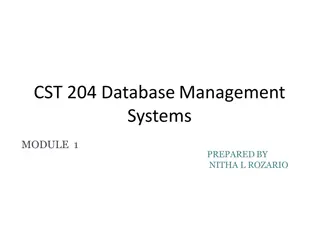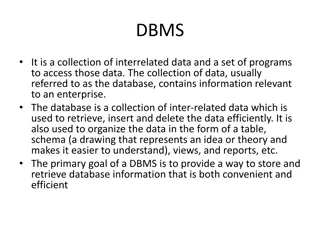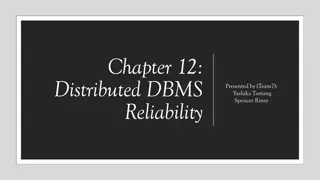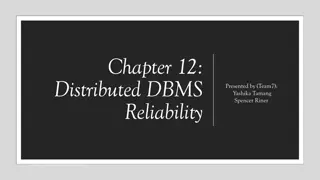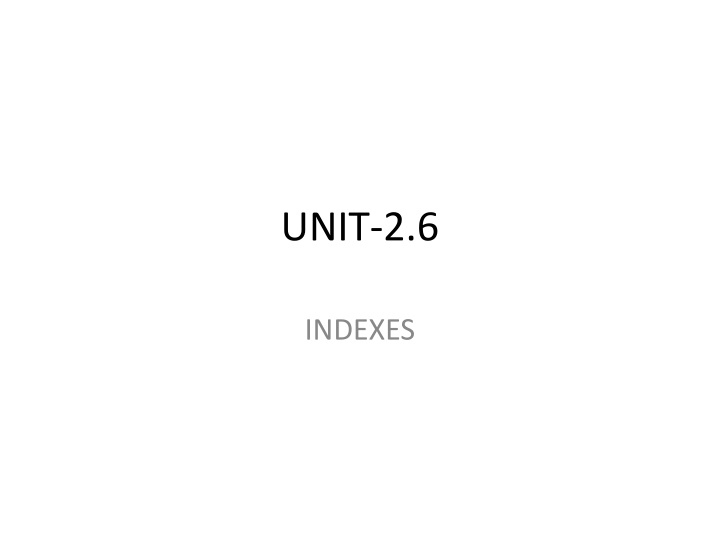
Optimizing SQL Performance with Indexes
Discover how SQL indexes can improve database query performance by quickly searching and retrieving data, along with guidelines for creating indexes and examples. Learn about unique indexes for maintaining data integrity.
Download Presentation

Please find below an Image/Link to download the presentation.
The content on the website is provided AS IS for your information and personal use only. It may not be sold, licensed, or shared on other websites without obtaining consent from the author. If you encounter any issues during the download, it is possible that the publisher has removed the file from their server.
You are allowed to download the files provided on this website for personal or commercial use, subject to the condition that they are used lawfully. All files are the property of their respective owners.
The content on the website is provided AS IS for your information and personal use only. It may not be sold, licensed, or shared on other websites without obtaining consent from the author.
E N D
Presentation Transcript
UNIT-2.6 INDEXES
SQL INDEX The Index in SQL is a special table used to speed up the searching of the data in the database tables. It also retrieves a vast amount of data from the tables frequently. The INDEX requires its own space in the hard disk. The index concept in SQL is same as the index concept in the novel or a book. It is the best SQL technique for improving the performance of queries. The drawback of using indexes is that they slow down the execution time of UPDATE and INSERT statements. But they have one advantage also as they speed up the execution time of SELECT and WHERE statements. In SQL, an Index is created on the fields of the tables. We can easily build one or more indexes on a table. The creation and deletion of the Index do not affect the data of the database.
Why SQL Index? The following reasons tell why Index is necessary in SQL: SQL Indexes can search the information of the large database quickly. This concept is a quick process for those columns, including different values. This data structure sorts the data values of columns (fields) either in ascending or descending order. And then, it assigns the entry for each value. Each Index table contains only two columns. The first column is row_id, and the other is indexed-column. When indexes are used with smaller tables, the performance of the index may not be recognized. Create an INDEX In SQL, we can easily create the Index using the following CREATE Statement: 1.CREATE INDEX Index_Name ON Table_Name ( Column_Name); Here, Index_Name is the name of that index that we want to create, and Table_Name is the name of the table on which The Column_Name represents the name of the column on which index is to be applied. If we want to create an index on the combination of two or more columns, then the following syntax can be used in SQL: 1.CREATE INDEX Index_Name ON Table_Name ( column_name1, column_name2, ...., col umn_nameN); the index is to be created.
Example for creating an Index in SQL: Let's take an Employee table: Emp_Id Emp_Name Emp_Salary Emp_City Emp_State 1001 Akshay 20000 Noida U.P 1002 Ram 35000 Jaipur Rajasthan 1003 Shyam 25000 Gurgaon Haryana 1004 Yatin 30000 Lucknow U.P The following SQL query creates an Index 'Index_state' on the Emp_State column of the Employee table.
CREATE INDEX index_state ON Employee (Emp_State); Suppose we want to create an index on the combination of the Emp_city and the Emp_State column of the above Employee table. For this, we have to use the following query: 1.CREATE INDEX index_city_State ON Employee (Emp_City, Emp_State); Create UNIQUE INDEX Unique Index is the same as the Primary key in SQL. The unique index does not allow selecting those columns which contain duplicate values. This index is the best way to maintain the data integrity of the SQL tables. Syntax for creating the Unique Index is as follows: 1.CREATE UNIQUE INDEX Index_Name ON Table_Name ( Column_Name); Example for creating a Unique Index in SQL: Let's take the above Employee table. The the Emp_Salary column of the Employee table. following SQL query creates the unique index index_salary on CREATE UNIQUE INDEX index_salary ON Employee (Emp_Salary);
Rename an INDEX We can easily rename the index of the table in the relational database using the ALTER command. Syntax: ALTER INDEX old_Index_Name RENAME TO new_Index_Name; Example for Renaming the Index in SQL: The following SQL query renames the index 'index_Salary' to 'index_Employee_Salary' of the above Employee table: ALTER INDEX index_Salary RENAME TO index_Employee_Salary; Remove an INDEX An Index of the table can be easily removed from the SQL database using the DROP command. If you want to delete an index from the data dictionary, you must be the owner of the database or have the privileges for removing it. Syntaxes for Removing an Index in relational databases are as follows: In Oracle database: DROP INDEX Index_Name; In MySQL database: ALTER TABLE Table_Name DROP INDEX Index_Name; In Ms-Access database: DROP INDEX Index_Name ON Table_Name; In SQL Server Database: DROP INDEX Table_Name.Index_Name;
Example for removing an Index in SQL: Suppose we want to remove the above 'index_Salary' from the SQL database. For this, we have to use the following SQL query: DROP INDEX index_salary; Alter an INDEX An index of the table can be easily modified in the relational database using the ALTER command. The basic syntax for modifying the Index in SQL is as follows: ALTER INDEX Index_Name ON Table_Name REBUILD; When should INDEXES not be used in SQL? The Indexes should not be used in SQL in the following cases or situations: SQL Indexes can be avoided when the size of the table is small. When the table needs to be updated frequently. Indexed should not be used on those cases when the column of a table contains a large number of NULL values.
The UNION Set Operator What if we wanted to make one table from all the content in the BOOKS and MOVIES tables? This is a perfect time to use UNION set operator. UNION merges the results of two SELECT statements. Important: UNION statements only return UNIQUE values. Below, you'll see a Venn diagram representing this operation and the code that will make it happen:
SELECT * FROM BOOKS UNION SELECT * FROM MOVIES Here is the result: ID 1 2 3 4 5 6 7 All the book and movie titles are now in one table. Note that "Harry Potter" an item which appears in both tables is shown only once in the results. Like we mentioned earlier, the UNION set operator does not return duplicate values. Title The Witcher Harry Potter Nineteen Eighty-Four The Great Gatsby Iron Man Dr Strange Matrix
The UNION ALL Set Operator You've probably guessed that UNION ALL is very similar to UNION, but with one exception: UNION ALL returns all data from all tables, no matter if it is a duplicate or not. Let's do the same operation as in the UNION example and see what we get:
SELECT * FROM BOOKS UNION ALL SELECT * FROM MOVIES ID 1 2 3 4 5 6 7 8 Title The Witcher Harry Potter Nineteen Eighty-Four The Great Gatsby Iron Man Harry Potter Dr Strange Matrix Firstly, know that there is a huge difference in efficiency between them. Let's say we need to merge two query results that each contain 10,000 elements. UNION will eliminate any duplicates and sort all the elements in the results table. This sorting process takes a lot of time and works with a large number of elements. In sum, UNION can be four times slower than UNION ALL, which doesn't eliminate duplicates and doesn't sort the data. If we don't care about duplicates and we want to work fast, UNION ALL will be the perfect solution. But if we know that having unique elements is our main goal, then UNION will be much more helpful.
The MINUS Set Operator MINUS is a little bit different. Let's say we want to see only book titles that are not also movie titles. We need to "minus" everything from the BOOKS table that is also in the MOVIES table. The MINUS set operator is designed for this type of task.
SELECT * FROM BOOKS MINUS SELECT * FROM MOVIES The result: ID 1 2 3 Title The Witcher Nineteen Eighty-Four The Great Gatsby Now "Harry Potter" doesn't appear in the results table; it's the title of a book and a movie. Thanks to the MINUS set operator we are able to see only those titles that occur in the first table and are not present in the second. By the way, some databases use the keyword EXCEPT instead of MINUS. Don't worry the function and results are exactly the same.
The INTERSECT set Operator This is the main role of the INTERSECT operator. Let's see how it works. SELECT * FROM BOOKS INTERSECT SELECT * FROM MOVIES And the result: ID 1 Title Harry Potter
SEQUENCES SEQUENCES Sequence is a set of integers 1, 2, 3, that are generated and supported by some database systems to produce unique values on demand. A sequence is a user defined schema bound object that generates a sequence of numeric values. Sequences are frequently used in many databases because many applications require each row in a table to contain a unique value and sequences provides an easy way to generate them. The sequence of numeric values is generated in an ascending or descending order at defined intervals and can be configured to restart when exceeds max_value.
Syntax: CREATE SEQUENCE sequence_name START WITH initial_value INCREMENT BY increment_value MINVALUE minimum value MAXVALUE maximum value CYCLE|NOCYCLE ; sequence_name: Name of the sequence. initial_value: starting value from where the sequence starts. Initial_value should be greater than or equal to minimum value and less than equal to maximum value. increment_value: Value by which sequence will increment itself. Increment_value can be positive or negative. minimum_value: Minimum value of the sequence. maximum_value: Maximum value of the sequence. cycle: When sequence reaches its set_limit it starts from beginning. nocycle: An exception will be thrown if sequence exceeds its max_value.
Example 1: CREATE SEQUENCE sequence_1 start with 1 increment by 1 minvalue 0 maxvalue 100 cycle; Above query will create a sequence named sequence_1.Sequence will start from 1 and will be incremented by 1 having maximum value 100. Sequence will repeat itself from start value after exceeding 100. Example 2: Following is the sequence query creating sequence in descending order. CREATE SEQUENCE sequence_2 start with 100 increment by -1 minvalue 1 maxvalue 100 cycle;
Example to use sequence : create a table named students with columns as id and name. CREATE TABLE students ( ID number(10), NAME char(20) ); Now insert values into table INSERT into students VALUES(sequence_1.nextval,'Ramesh'); INSERT into students VALUES(sequence_1.nextval,'Suresh'); where sequence_1.nextval will insert id s in id column in a sequence as defined in sequence_1. Output: ______________________ | ID | NAME | ------------------------ | 1 | Ramesh | | 2 | Suresh | ----------------------


